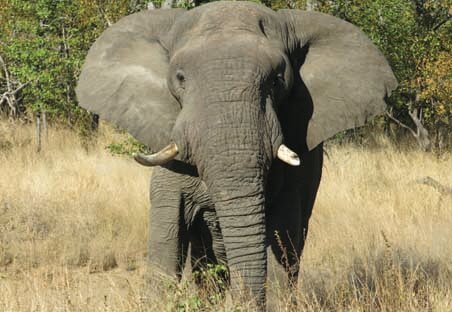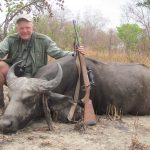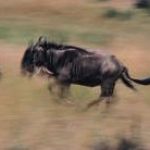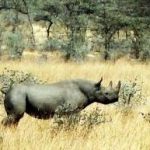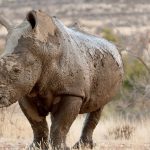Once a cattle region, now a hunting mecca, Zimbabwe’s Bubye Valley Conservancy shows how hunting can help both humans and wildlife to flourish.
Zimbabwe’s Bubye Valley Conservancy (BVC) lies in the southern portion of the country, comprising portions of both the Matabeleland South and Masvingo Provinces. In the early 1900s, huge cattle operations were established on the two-million-acre property and livestock remained the principle source of revenue in that area until the early 1980s. But there are issues inherent to such large cattle operations in southern Zimbabwe; the fragile Lowveld soil is not conducive to large livestock; native species competed with domestic cattle (and were subsequently exterminated); and local communities did not share in the profits from these operations. In addition, periodic drought is common in the region, and die-offs of domestic stock were commonplace in especially dry years. Lions, elephants, rhinos, wild dogs, and buffalo were extirpated, and a bounty was paid for anyone who presented the tail of a zebra or wildebeest as these two species represented the primary competition for the domestic herds.
When the Bubye Valley Conservancy was formed, elephants were reintroduced along with many other native species.
Following the brutal droughts of 1982¬1983 and 1991¬1992, ranchers in the region began to face the reality that cattle operations were not the best financial option in the arid Lowveld. A group of investors, spearheaded by Charles Davy, purchased the remaining LEMCO (Liebigs Extract of Meat Company) lands and several adjacent farms and established the Bubye Valley Conservancy. A double, seven-foot electrified perimeter fence was erected around the entire boundary of the 1,250-square-mile property (larger than the King Ranch in Texas); the double fence had a 30-foot gap to separate the conservancy’s buffalo from neighboring cattle to control the spread of hoof-and-mouth disease. A number of native wildlife species were then reintroduced into BVC. Since they were adapted to the environment, these native species—lions, buffalo, elephants, wild dogs, rhinos, and many others—thrived in the BVC. And, of equal importance, they did not damage the habitat as the domestic livestock had. As wildlife populations grew, the habitat improved, and soon the massive BVC landholdings looked much as they did in the days prior to the introduction of cattle. Shareholders paid the bills for the establishment of safari camps, game reintroduction, anti-poaching measures, and the perimeter fence until the funds from safari hunting could support BVC operations.
The funds generated by sport hunting have helped not only the wildlife in BVC but also local communities around the conservancy. The statistics speak for themselves: Since 2011, eight bore holes have been drilled to provide fresh water to schools and villages, youth athletic teams have been able to afford uniforms and transportation to sporting events, cold rooms and refrigeration units have been established to store fresh meat, schools were provided with new buildings, restrooms, doors, windows, and roofs. Most important of all, more than three and a half tons of fresh meat is donated monthly to local schools, villages, and orphanages. The lengthy list of improvements continues (for complete totals visit bubyevalleyconservancy.com), but the message is clear: When wildlife is managed for hunting and local communities either benefit or become shareholders in the responsible use of natural resources, then wildlife has a future in Africa.
From the establishment of the first cattle ranches in the region until the early 2000s, rhinos were scarce in the BVC—the sole population was a handful of white rhinos that had been imported from South Africa. That changed in 2002, when 135 black rhinos were reintroduced to BVC, making the area home to the third-largest population of black rhinos in the world and the largest collection of rhinos on private ground (only Etosha Park in Namibia and Kruger Park in South Africa are home to larger herds).
“This population is highly valuable not only in terms of numbers of individuals, but possibly more importantly in terms of genetic viability,” says professional hunter John Sharp, who operates in the BVC. “The black rhinos in BVC are of Zambezi Valley stock—in fact some of the black rhinos living on BVC today were actually born in the Zambezi Valley. The 35-year-old bull, Shrapnel, was captured in 1992 in Chete. The forty-year-old cow, Inunwa, was captured near Rekomechi Bridge on the way into Mana Pools. These rhinos contain vital genetic diversity as they are from what in the late 1980s was the world’s largest population of black rhinos, estimated at in excess of 1,700—over half the world’s population at the time. South Africa and Namibia had barely 500 black rhinos each at this time.”
The War on Poaching
The Bubye Valley’s rhino population is carefully maintained and monitored, but even this remote corner of Africa is not immune from the infiltration of poaching gangs who—fueled by a rise in the value of rhino horn and equipped with an effective arsenal of semiautomatic and automatic weapons with telescopic sights and silencers—began targeting the BVC rhinos mercilessly in the late 2000s.
In early 2008, criminal syndicates behind the massive rhino poaching in South Africa turned their attention to BVC in conjunction with Zimbabwean gangs who had almost annihilated the rhinos in other areas within Zimbabwe. Between 2008 and 2009, an adjacent property lost all seventy-two of their rhinos to these gangs, and BVC scouts suddenly had to shift their attention from local poachers using dogs and snares to well-funded, well-organized militias bent on exterminating rhinos for profit. The funds generated by hunters and non-governmental organizations helped equip the anti-poaching units to fight a more sophisticated and far more dangerous enemy.
BVC issued each of its eighty scouts semi-automatic .223-caliber rifles. Secure communication networks were established. Training in basic tactics was conducted to build confidence. Working with staff from other conservancies, intelligence was gathered on the poaching syndicates. By mid-2010, after losing some fifty rhinos, the tide turned and losses dropped dramatically as the opposition suffered several major setbacks and found that there were easier pickings elsewhere.
Unfortunately, the potential profits for slaughtering rhinos spurred these armed syndicates to regroup and reorganize. Soon poachers began incentivizing BVC scouts to provide intel that allowed them to operate once again in the Bubye Valley.
A key factor that assisted the resurgence of poaching was there being cell phone coverage in most parts of the BVC. This provided poachers with real-time intelligence on deployments, detection of incursions and whereabouts of rhinos. Poachers also perfected a system of crossing the two perimeter fences without leaving any evidence of their passing. (They put socks over their shoes, foiling even expert trackers.) They also became very mobile, on occasion traversing the BVC from east to west, some forty-four miles, in twelve hours, negating the efforts of stop groups. But the BVC did not back down; the rhinos in their charge were not their own property but the property of the Zimbabwean people, and with funds from hunting and private donations, BVC upgraded its fences, paid substantial sums for information leading to the capture of poachers, organized a rapid-response unit to quickly address poachers, undertook more advanced training and, in 2016, added a canine response unit. Poachers have responded by trying to ambush rangers; to date, thankfully, there has only been one relatively minor injury. The BVC has become one of the hotbeds in the war on Africa’s poachers, but thanks to the funds generated by hunting and the selfless efforts of dedicated scouts on the ground, the BVC rhinos are surviving. Were it not for hunter dollars, these valuable animals would have been lost long ago.
The King is Back
“As the apex predator, lions are a vital component of functioning ecosystems,” Sharp says. “However, without the incentive of trophy hunting, we could not afford to have as many lions as we do. Lions eat other animals, and in real terms consume hundreds of thousands of dollars’ worth of wildlife on the conservancy each year. Lion hunts are not cheap, but this is why. If we were unable to continue harvesting our lions, their population size would unfortunately need to come down, and this means culling them, as there is currently nowhere left in Africa to introduce a viable lion population.”
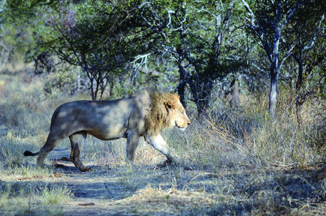
The future of places like BVC is crucial to the future of lions in Africa.
Lion ecology is widely misunderstood. The general public seems determined to vilify trophy hunting when, in reality, the loss of habitat, a rapidly-growing human population, and poaching for profit are the true risks to wild lions. To that end, the BVC has partnered with the University of Oxford Wildlife Conservation Unit to help study these cats in the BVC.
“Lions are an important cog that makes the ecological machine work, and we don’t want to lose the lions,” Sharp says. “Responsible trophy hunting cannot significantly affect lion population density or survival, as it is only the old males no longer contributing to the gene pool or protecting their pride that are hunted. Indeed, the lion abundance has increased exponentially despite, and indirectly because of, hunting.”
Sharp points out that the BVC’s success with lions has resulted in the area accounting for more than a third of the CITES harvest quota for the entire nation of Zimbabwe. In late 2015, BVC representatives, along with lion experts from Hwange Park and the Save Valley Conservancy, met with officials from the U.S. Fish and Wildlife Service to discuss the future of lions and lion hunting in Zimbabwe. According to the official USFWS statement, “The Service found that sport-hunting, if well managed, may provide a benefit to the subspecies. Well-managed conservation programs use trophy-hunting revenues to sustain lion conservation, research and anti-poaching activities. However, the Service found that not all trophy hunting programs are scientifically based or managed in a sustainable way. So in addition to protecting both lion subspecies under the ESA, we created a permitting mechanism to support and strengthen the accountability of conservation programs in other nations.”
The fact that there are any lions at all in the conservancy is a testament to the BVC’s commitment to conservation. While lion populations continue to decline across much of the continent, the Bubye Valley’s population of big cats remains stable thanks to careful management bolstered by ecological research. More importantly, the future of lions in the valley is a benefit to the shareholders who live alongside these cats. Since there are more wild lions on hunting areas today than in parks and preserves in Africa, it is time that the world began to understand why the future of places like the BVC is congruent with the future of the lion as a species.
The Bubye Valley Conservancy is an example of what hunter-based conservation can accomplish in Africa. The financial success of the BVC has provided for local people and incentivized them to protect wildlife. The funding has also helped provide ground troops to fight the war on poaching. It’s important to note that the original shareholders who established the BVC twenty years ago have not seen any personal financial gain from the success of the conservancy; the money returns directly to the communities and to the preservation of wildlife. The vast, remote BVC remains one of Africa’s great ecosystems, with healthy game populations and a goal for long-term conservation in a world consumed with rapid profit. And we have hunters to thank.

